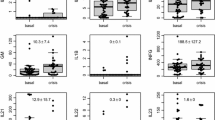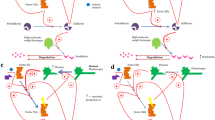Abstract
Hereditary angioedema (HAE) is a rare autosomal dominant disorder, due to C1-inhibitor deficiency, which causes episodic swellings of subcutaneous tissues, bowel walls and upper airways which are disabling and potentially life-threatening. We evaluated n = 17 patients with confirmed HAE diagnosis in basal and crisis state and n = 19 healthy subjects. The samples were tested for IL-17, FGFb, G-CSF and GM-CSF, using Bio-plex kit. Data analysis was performed via nonparametric Spearman’s correlations and two sets of linear mixed models. When comparing HAE subjects during basal and crisis states, we found out significantly (i.e., p value <0.05) higher values in crisis states rather than in basal states for the three growth factors and cytokine IL-17. When comparing healthy subjects versus HAE patients at basal state, we found out significantly higher values in HAE subjects only for GM-CSF, FGFb and IL-17, but not for G-CSF. In HAE patients, there is a connection between IL-17 and growth factors. The low-grade inflammation in absence of attacks is demonstrated by constant higher amount of IL-17, FGFb and GM-CSF with respect to healthy patients. This could indicate that in this disease there is a level of activation that maintains the system in a “tick-over state,” that can be activate by several stimuli that are able to induce a increase in inflammatory mediators during the acute attack.

Similar content being viewed by others
References
Agostoni A, Cicardi M. Hereditary and acquired C1-inhibitor deficiency: biological and clinical characteristics in 235 patients. Medicine (Baltimore). 1992;71(4):206–15.
Csuka D, Füst G, Farkas H, Varga L. Parameters of the classical complement pathway predict disease severity in hereditary angioedema. Clin Immunol. 2011;139(1):85–93.
Davis AE 3rd, Cai S, Liu D. C1 inhibitor: biologic activities that are independent of protease inhibition. Immunobiology. 2007;212(4–5):313–23.
Heeres M, Visser T, van Wessem KJ, Koenderman AH, Strengers PF, Koenderman L, Leenen LP. The effect of C1-esterase inhibitor on systemic inflammation in trauma patients with a femur fracture—the CAESAR study: study protocol for a randomized controlled trial. Trials. 2011;11(12):223.
Cillari E, Misiano G, Aricò M, La Rocca E, Lio D, di Leonardo S, Brai M. Modification of peripheral blood T-lymphocyte surface receptors and Langerhans cell numbers in hereditary angioedema. Am J Clin Pathol. 1986;85(3):305–11.
Arcoleo F, Salemi M, La Porta A, Selvaggio V, Mandalà V, Muggeo V, Misiano G, Milano S, Romano GC, Cillari E. Upregulation of cytokines and IL-17 in patients with hereditary angioedema. Clin Chem Lab Med. 2014;52(5):e91–3.
Ouyang W, Kolls JK, Zheng Y. The biological functions of T helper 17 cell effector cytokines in inflammation. Immunity. 2008;28(4):454–67.
Pelletier M, Maggi L, Micheletti A, Lazzeri E, Tamassia N, Costantini C, Cosmi L, Lunardi C, Annunziato F, Romagnani S, Cassatella MA. Evidence for a cross-talk between human neutrophils and Th17 cells. Blood. 2010;115(2):335–431.
Fleetwood AJ, Lawrence T, Hamilton JA, Cook AD. Granulocyte-macrophage colony-stimulating factor (CSF) and macrophage CSF-dependent macrophage phenotypes display differences in cytokine profiles and transcription factor activities: implications for CSF blockade in inflammation. J Immunol. 2007;178(8):5245–52.
Braun S, auf dem Keller U, Steiling H, Werner S. Fibroblast growth factors in epithelial repair and cytoprotection. Philos Trans R Soc Lond B Biol Sci. 2004;359(1445):753–7.
West B, Welch K, Galecki A. Linear mixed models: a practical guide using statistical software. London: Chapman & Hall/CRC; 2007. p. 21–9.
Feliciani C, Gupta AK, Sauder DN. Keratinocytes and cytokine/growth factors. Crit Rev Oral Biol Med. 1996;7(4):300–18.
Forlow SB, Schurr JR, Kolls JK, Bagby GJ, Schwarzenberger PO, Ley K. Increased granulopoiesis through interleukin-17 and granulocyte colony-stimulating factor in leukocyte adhesion molecule-deficient mice. Blood. 2001;98(12):3309–14.
Kajdácsi E, Jani PK, Csuka D, Varga LA, Prohászka Z, Farkas H, Cervenak L. Endothelial cell activation during edematous attacks of hereditary angioedema types I and II. J Allergy Clin Immunol. 2014;133:1686–91.
Cornish AL, Campbell IK, McKenzie BS, Chatfield S, Wicks IP. G-CSF and GM-CSF as therapeutic targets in rheumatoid arthritis. Nat Rev Rheumatol. 2009;5:554–9.
Ogawa A, Andoh A, Araki Y, Bamba T, Fujiyama Y. Neutralization of interleukin-17 aggravates dextran sulfate sodium-induced colitis in mice. Clin Immunol. 2004;110(1):55–62.
Ohsawa I, Nagamachi S, Suzuki H, Honda D, Sato N, Ohi H, Horikoshi S, Tomino Y. Leukocytosis and high hematocrit levels during abdominal attacks of hereditary angioedema. BMC Gastroenterol. 2013;2(13):123.
Jakubowski A, Gabrilove J. Granulocyte colony stimulating factor (G-CSF): biology and clinical status. Cancer Biother Radiopharm. 1996;11(1):5–20.
Platten M, Youssef S, Hur EM, Ho PP, Han MH, Lanz TV, Phillips LK, Goldstein MJ, Bhat R, Raine CS, Sobel RA, Steinman L. Blocking angiotensin-converting enzyme induces potent regulatory T cells and modulates TH1- and TH17-mediated autoimmunity. Proc Natl Acad Sci USA. 2009;106(35):14948–53.
Nussberger J, Cugno M, Amstutz C, Cicardi M, Pellacani A, Agostoni A. Plasma bradykinin in angio-oedema. Lancet. 1998;351(9117):1693–7.
Acknowledgments
We are grateful to Dr. Eleonora Consiglio for her help in the preparation of the manuscript.
Conflict of interest
The authors declare that they have no conflict of interest.
Ethical standard
All procedures performed in studies involving human participants were in accordance with the ethical standards of the institutional and/or national research committee and with the 1964 Helsinki declaration and its later amendments or comparable ethical standards. This article does not contain any studies with animals performed by any of the authors.
Informed consent
Informed consent was obtained from all individual participants included in the study.
Author information
Authors and Affiliations
Corresponding author
Rights and permissions
About this article
Cite this article
Salemi, M., Mandalà, V., Muggeo, V. et al. Growth factors and IL-17 in hereditary angioedema. Clin Exp Med 16, 213–218 (2016). https://doi.org/10.1007/s10238-015-0340-y
Received:
Accepted:
Published:
Issue Date:
DOI: https://doi.org/10.1007/s10238-015-0340-y




